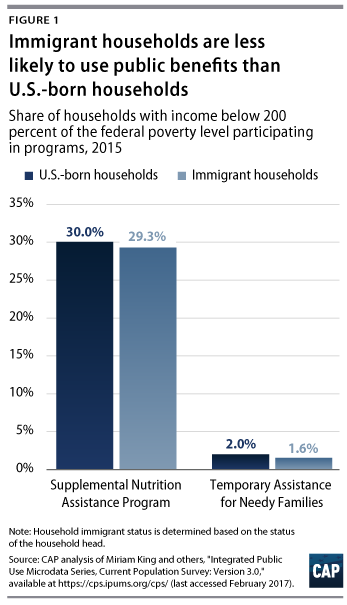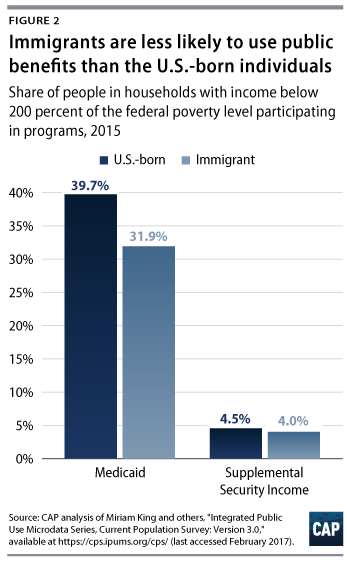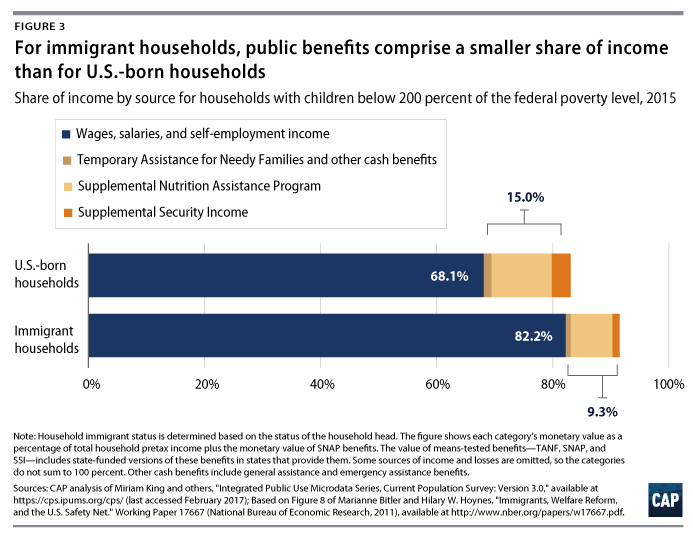President Donald Trump is actively considering opening a new front in his war on immigrants through another hastily drafted and vaguely worded executive order. Drafts of this new order have been leaked to various press outlets and offer a worrying look into the administration’s complete disregard for commonsense immigration policy. If issued, the order would expand the focus of the administration’s anti-immigrant campaign beyond unauthorized immigrants, refugees, and Muslims—groups that Trump’s campaign and administration have already targeted extensively—to include green card holders—also known as lawful permanent residents, or LPRs—living in the United States. It would also affect potential immigrants seeking visas to lawfully enter the United States to reunite with family members.
Under the draft order, individuals who are otherwise eligible for green cards could be denied admission to the United States if they could conceivably become eligible for any kind of means-tested assistance. What’s more, legal immigrants could be deported for needing to turn to public assistance.
The pretexts for the leaked order are the myths that the cost of immigration exceeds its benefits and that millions of green card holders are so-called public charges who are a drain on the government. The reality is that immigrants contribute massively to the nation’s economy and society. Furthermore, as the new Center for American Progress analysis in this column shows, working-class families headed by immigrants are Iess likely to access public benefits than working-class families headed by U.S.-born individuals.
This column walks through what Trump’s order would do and whom it would affect. The authors provide a new analysis showing that, contrary to Trump’s misleading rhetoric, working-class immigrants are significantly less likely than U.S.-born individuals to access public assistance.
The order would radically expand Trump’s power
The most sweeping component of the order would greatly expand the definition used to determine whether potential immigrants seeking a green card to lawfully immigrate to the United States can be denied because they are likely to become a “public charge.” Under long-standing U.S. law and policy, “likely to become a public charge” means that an individual is likely to become primarily dependent on “public cash assistance for income maintenance or institutionalization for long-term care.” Under the draft order, applicants who are otherwise eligible for a green card may be denied LPR status or admission to the United States if they are deemed likely to receive any means-tested public benefit. As currently drafted, the order would even allow federal officials to deport LPRs if they receive such benefits during their first five years in the United States.
The order also contains several other provisions that would harm U.S. citizens, green card holders, and others. For example, it would prevent many U.S. citizen children of immigrants from getting the critically important Child Tax Credit, or CTC. All U.S. citizen children are currently eligible for the CTC, but the executive order would deny the CTC to citizen children who have taxpaying parents or guardians who are not eligible for a Social Security number. Besides being unfair, this cut is shortsighted because the CTC improves children’s long-term outcomes.
The pretext for the leaked executive order is false
Immigrants make huge contributions to the U.S. economy and American society. Their hard work boosts gross domestic product, or GDP; their purchasing power benefits U.S. businesses of all sizes; and the federal, state, and local taxes they pay help fund public services and sustain Social Security and Medicare. In 2015, immigrants represented 27.5 percent of all new entrepreneurs in the United States and played a significant role in local economies. Immigrants make tremendous contributions, but just like the general U.S. population—80 percent of whom will experience at least a year of significant economic insecurity during their working years—they are not superhuman. This order would block or strongly deter lawfully present families from legally accessing needed assistance, even if they meet other eligibility requirements. It would also discourage people from providing sponsorship to immigrants.
Immigrants access fewer public benefits than U.S.-born individuals
Immigrants are subject to the same economic risks and labor-market realities as U.S.-born individuals. For millions of poorly compensated workers, public programs support work, re-employment, and social integration. Past studies have found that low-income immigrants use public benefits at lower or similar rates when compared to U.S.-born individuals and that they tend to rely to a greater extent on earned income.
New CAP analysis of the 2016 March Current Population Survey confirms these findings. The authors find that low-income immigrant-headed households are less likely than households headed by those born in the United States to participate in the Supplemental Nutrition Assistance Program or SNAP, which protects families from hunger while also improving long-run outcomes—particularly for children—in the areas of health, educational attainment, and earnings and economic independence during adulthood. The same is true of Temporary Assistance for Needy Families, or TANF, which assists families with children facing extreme economic need. (see Figure 1)

Likewise, immigrants also access Supplemental Security Income, or SSI, and Medicaid at lower rates than U.S.-born individuals, as shown in Figure 2. SSI, which immigrants are half a percentage point less likely to access, provides modest assistance for basic needs to low-income seniors and disabled individuals. Medicaid, in which low-income immigrants are 7.8 percentage points less likely to participate, helps low-income families, seniors, and people with disabilities access critical health care.

Public assistance programs promote economic mobility
Immigrants and other foreign-born individuals are already severely restricted in terms of the federal public assistance they can access during times of need. In fact, even green card holders are generally ineligible for federal means-tested programs—including Medicaid, SNAP, SSI, and TANF—during their first five years in the United States.
Research shows that programs such as SNAP, Medicaid, and tax credits for working families do not simply improve short-term outcomes. They also lead to better outcomes in the long term, including better health, lower mortality rates, greater educational attainment, and government savings. Further restricting access to programs such as Medicaid and SSI would harm children, seniors, people with disabilities, and low-income adults with serious short- and long-term consequences, including for the future U.S. workforce.
A greater share of immigrant households’ income comes from their earnings
Additionally, working-class households—those with incomes less than twice the federal poverty line—headed by an immigrant rely to a much greater extent on their earnings from work and less on public programs than working-class households headed by a U.S.-born person.

Among working-class households with children in 2015, those headed by a U.S.-born person received 15 percent of their overall income from SNAP, TANF, and SSI, while those headed by an immigrant received only 9.3 percent of their overall income from these same public programs. In other words, on average, working-class households headed by U.S.-born individuals received 1.5 times more of their annual income from these three public programs than those headed by immigrants. That said, it is also important to note that the average share of income from public-assistance programs is modest in practical terms for both groups.
The effects of the executive order would extend far beyond foreign-born individuals
Trump’s executive order would not simply affect foreign-born individuals. CAP’s analysis finds that the majority of immigrant-headed households, especially those receiving SNAP or TANF, include one or more citizens. More than 6 in 10 immigrant-headed households participating in SNAP and more than 8 in 10 participating in TANF include at least one citizen. Many of these citizens in the immigrant-headed households are children. In 2015, there were nearly 15.8 million U.S.-born minor children with one or more foreign-born parents. These U.S. citizen children should not be penalized simply because their parents were born abroad.
Conclusion
President Trump’s anticipated executive order is the latest piece of his damaging agenda to dehumanize immigrants. It willfully ignores the reality that immigrants are not only valued members of American families and communities but also tremendous contributors to the nation’s economy and prosperity.
Moreover, by increasing barriers to public health and nutrition services, the executive order would threaten the well-being of immigrants and citizens alike, undermining families’ health and safety. Such a policy is shortsighted and defies common sense. And given the large body of research showing that programs such as Medicaid, nutrition assistance, and tax credits for working families both mitigate hardship in the short-term and improve long-run outcomes—particularly for children—this order could have far-reaching consequences for the next generation.
The American dream is premised on the idea that anyone can come to this country with few resources, but a lot of potential, and make enormous contributions. President Trump’s radical proposal would upend this basic value and restrict even legal immigration. This proposed executive order is not only anti-family; it is also un-American.
Methodology note
In their analysis of the 2016 March Current Population Survey, the authors identify as immigrants all foreign-born individuals, except those who are born abroad to American parents. The authors omit from the sample all individuals for whom nativity is reported unless they report both a citizenship status—naturalized citizen or noncitizen—and a specific year of migration.
[Silva Mathema is a Senior Policy Analyst for the Immigration team at the Center for American Progress. Rachel West is an Associate Director for the Poverty to Prosperity Program at the Center. Shawn Fremstad is a Senior Fellow at the Center.]


Spread the word